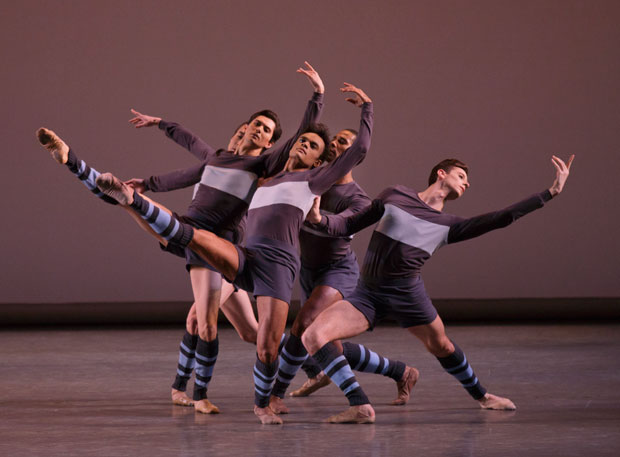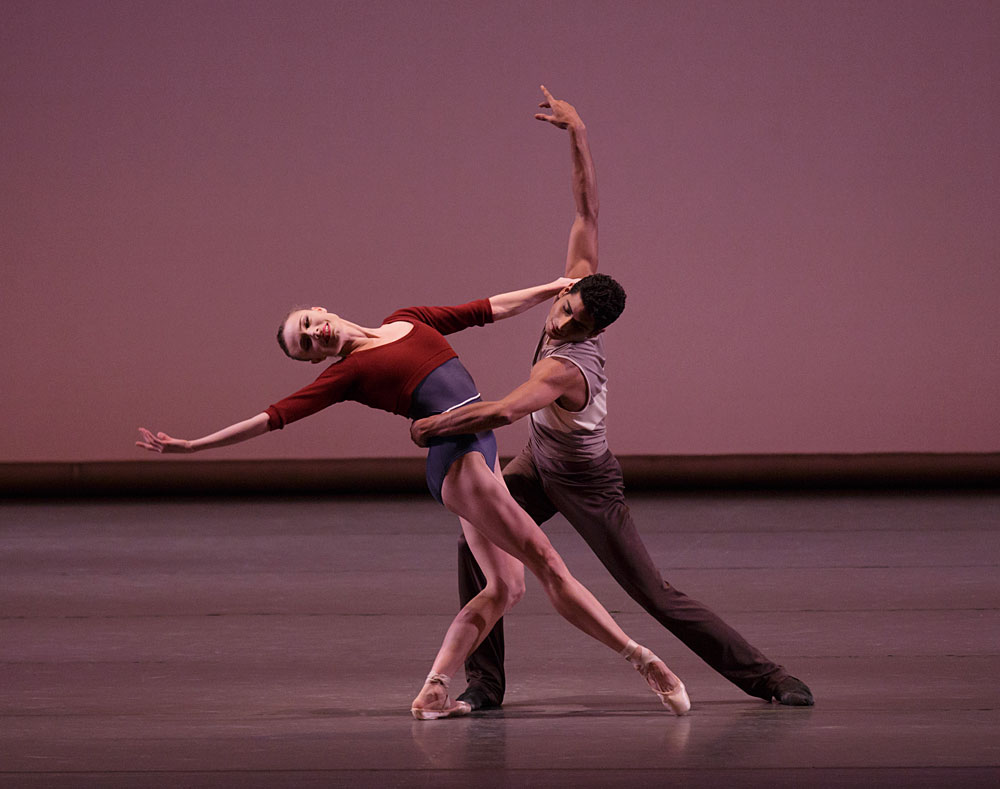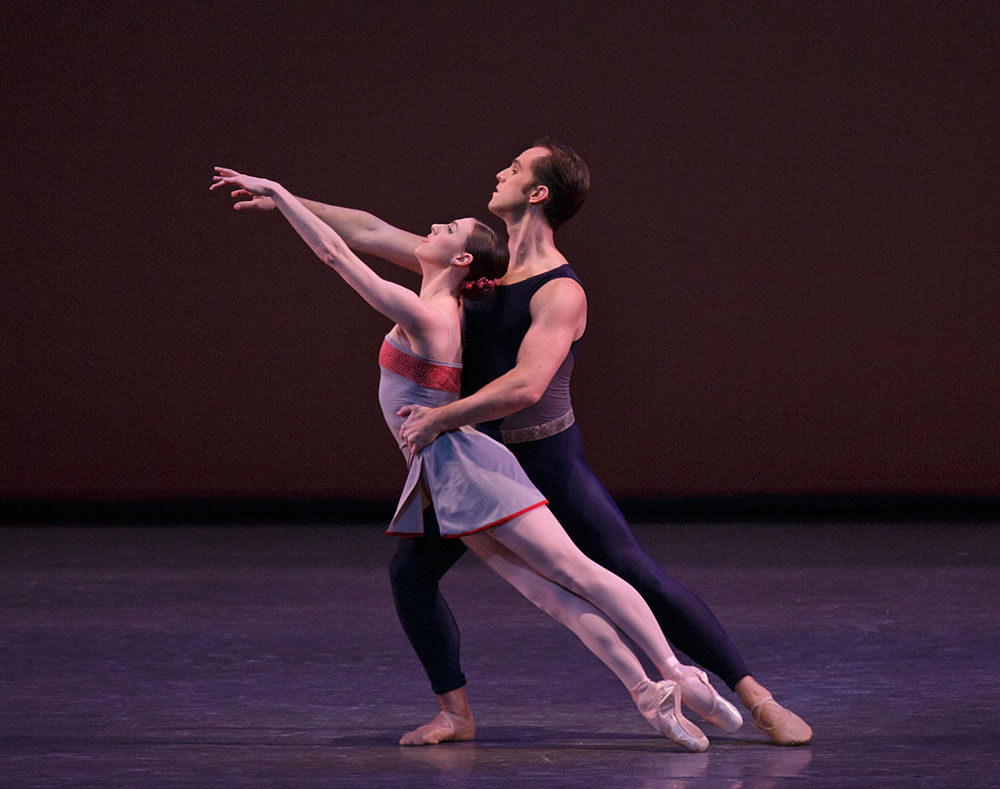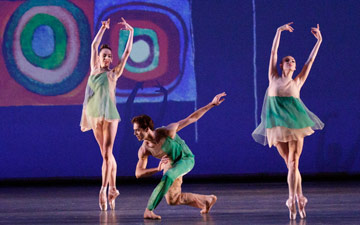
© Paul Kolnik. (Click image for larger version)
New York City Ballet
Pictures at an Exhibition,’Rōdē,ō: Four Dance Episodes, Mercurial Maoeucres
New York, David H. Koch Theater
8 February 2015
www.nycballet.com
Off to the Races
For his newest ballet, the eighth at his alma mater, Justin Peck has chosen Aaron Copland’s irresistible score for the 1942 Agnes de Mille ballet Rodeo. (Or rather, the symphonic suite Copland later arranged from the same material.) On Wednesday, when ‘Rōdē,ō: Four Dance Episodes premièred, Peck was forced to step into one of the principal roles, replacing the injured Andrew Veyette. But by the Sunday matinée new casting had been sorted out. Sean Suozzi replaced Veyette in what turns out to be a real steeple-chase of a ballet.
The decision to take this music in hand is a brave one. Copland’s score inevitably evokes images from the earlier ballet: cowboys roping horses, farmhands ambling across the range on their way to the town dance. De Mille’s ballet is an American classic, and rightly so. But this is music that just begs to be danced, and Peck has made a ballet that is all about that impulse, the desire to move, the propulsive effect of rhythm, the jolt of syncopation. The ballet begins with men running across the stage, and from that moment on it barely pauses for breath. Instead of looking West, Peck has linked the music to imagery from sports, the energy of male camaraderie, the thrumming of machinery, the thrill of virtuosity.

© Paul Kolnik. (Click image for larger version)
In a sly way, his casting also alludes to the original. De Mille’s ballet was about a tomboy searching for her place in a male-dominated world. Here, Peck casts 15 men – led by Amar Ramasar, Gonzalo García, Sean Suozzi, and Daniel Ulbricht – and a single woman, Sara Mearns. The ballet is a gift to the men of the company, but also to Mearns, who proves, as one knew she would, that she more than holds her own. Reid Bartelme and Harriet Jung have dressed Mearns in a grey and wine-colored leotard, barelegged, the better to show off those fantastically strong legs of hers, all muscle and tendon and raw power. The men’s costumes look like rugby uniforms: shorts paired with long socks and tops with a stripe across the chest.
It turns out that this combination of male vigor, Copland, and Peck is a felicitous one. It’s exciting to see just how many layers Peck hears in the music, how details of orchestration find their echo in movements on the stage, a fast or slow port de bras, round and then straight arms, tilting shoulders, and, in one thrilling moment, the paddling of hands and feet, like a school of fish swimming upstream. During a sudden pause at the apex of a melody a man is held aloft, legs crossed, seemingly frozen in time. To a rallentando on the trumpet, Daniel Ulbricht executes a marvelous decelerating series of turns with one leg extended to the side (a staple of male virtuosity).

© Paul Kolnik. (Click image for larger version)
Despite its sporty, youthful tone – there’s even a funny moment when four men sit on the edge of the stage, their legs dangling into the pit – ‘Rōdē,ō also has more meditative moments. During the slow second movement, five men come together in interlocking formations, pushing against each other to form chains that strain toward the front of the stage. As always, Peck’s ingenuity in moving the ensemble is one of his most notable talents. The dancers’ bodies become segments in multi-partite machines, their limbs like turnstiles and levers.
At first, Mearns comes on almost unnoticed, dancing for herself as the men continue their games. By the finale, she’s one of the gang. But in the next-to-last “episode” (originally the “Saturday Night Waltz”), she and Amar Ramasar dance together, alone. They face each other on an equal footing, running in wide arcs toward each other, then pushing off of each other’s bodies and spiraling away into their own spheres. There’s more camaraderie between them than love. It’s an interesting idea, but the music is so achingly lyrical here, one wishes for something more. Peck hasn’t completely unlocked the mystery of the pas de deux, the way it can stand in for our deepest longings and emotions. But romance isn’t everything, and this Rōdē,ō will surely reward multiple viewings.

© Paul Kolnik. (Click image for larger version)
In contrast, Christopher Wheeldon, whose Mercurial Manoeuvres closed this program of works by contemporary choreographers, is a master of the pas de deux. The central duet here was danced by Tiler Peck and Jared Angle, with their usual finesse. It is an example of Wheeldon’s great skill at creating seamless, fluid conjoinings of the male and female body. He makes the dancers look as if they were moving through something heavier and thicker than air. But, as with the rest of this ballet, there is something missing, a deeper connection to the music, a sense of purpose. Mercurial Manoeuvres, set to Shostakovich’s First Piano Concerto, is an extremely handsome, artfully-designed piece that somehow misses the the sardonic, cartoonish, and off-kilter character of Shostakovich’s music. The music laughs and teases; the choreography neatly organizes. In the central male role, Anthony Huxley suffered from a similar problem: flawless execution, lacking in accent.

© Paul Kolnik. (Click image for larger version)
On the other hand Alexei Ratmansky’s Pictures at an Exhibition, the first ballet on the program, is all about character. Set to Mussorgsky’s eponymous suite – played with confidence and verve by Cameron Grant – the ballet is just as delightfully weird and full of surprises as it seemed last season when it premièred. Each section creates its own little world: a shaman (Ramasar) conjures energies from the air, stomping out a demonic dace; two men (Tyler Angle and Joseph Gordon) search and lose each other in a shifting landscape; a couple (Gretchen Smith and Adrian Danchig-Waring), possibly blind, feels its way through the darkness. The tone shifts dramatically from one moment to the next, from playful to tongue-in-cheek to histrionic or mysterious. Perhaps the best way to imagine this ballet is as a series of fairy tales. What’s clear is that the dancers’ imaginations are fully awakened by it; as a result their dancing is rich, textured, and full of contrast.
In the otherwordly pas de deux originally created for Wendy Whelan, filled with images of flight, Whelan’s role has passed on to Sterling Hyltin. Hyltin, delicate and feminine, has yet to place her stamp on it. Whelan’s interpretation was very much her own: remote, almost bird-like. But the final image, in which the woman seems to ascend from her partner’s chest, reaching toward the sky, remains as haunting as ever.

















Thank you for, as ever, a vivid review.
I have heard the extraordinary Tiler Peck described in many different ways – deservedly so – but not – as is the case here in the penultimate paragraph – as a ‘man’. That is truly unique.
Apologies – In a passing reference, I confused Tiler Angle and Tyler Peck—the names, not the dancers themselves! It has since been corrected.